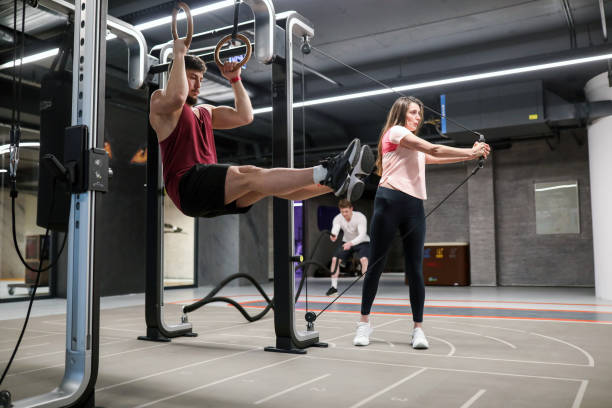The words “fitness” and “health” often make us think of tough workouts, strict diets, and a quick, intense effort to shed some weight. But what if we told you that true fitness for life isn’t a short-term sprint, but a lifelong journey? The key to long-term health isn’t extreme diets you can only stick to for a few weeks. Instead, it’s about creating a fun and flexible lifestyle. This way, you can support your well-being for many years.
This is the ultimate guide to “Fitness for Life.” It’s a complete blueprint that goes beyond the gym floor and into the kitchen, the bedroom, and even your mind. We’ll look at key principles to keep you motivated. You’ll get a clear guide for movement and nutrition. Plus, we’ll show you how to make rest and recovery essential parts of your health. By the end of this article, you will have a comprehensive plan to build a healthy lifestyle that you not only stick to, but truly love.
The Foundational Principles of Fitness for life
Contents
- 1 The Foundational Principles of Fitness for life
- 2 Pillar 1: The Blueprint for a Lifetime of Movement
- 3 Pillar 2: Nutrition as Fuel, Not Punishment
- 4 Pillar 3: The Indispensable Role of Rest and Recovery
- 5 The Social Side of Fitness: Why Community and Accountability Matter
- 6 Putting It All Together: Creating Your “Forever” Plan
- 7 Frequently Asked Questions (FAQs)
Before we get to the specifics, let’s establish the mindset. A “forever” plan is built on a few core beliefs that separate sustainable health from a temporary fix.
Consistency Over Intensity
The biggest mistake people make is trying to do too much, too soon. They go from zero workouts to five intense sessions a week, only to burn out and quit after a month. The key to lifelong fitness is consistency. A moderate workout you do four times a week, every week, is far more effective than an intense one you do sporadically. It’s the small, consistent actions that compound over time to create a powerful, lasting change.
Listen to Your Body
Your body is an incredible machine, and it’s always sending you signals. A plan for life requires you to listen to those signals. This means knowing the difference between a little soreness and a real injury. It means taking a rest day when you feel rundown and choosing a light walk over a heavy lifting session when you’re feeling tired. Your forever plan should be flexible enough to adapt to your body’s needs.
Find Joy in Movement
You will not stick with a fitness plan that you hate. It’s that simple. Forget what you “should” be doing and find something you genuinely enjoy. If you hate running, don’t run! If you love to dance, take a dance class. If you find peace in nature, go for hikes. The goal is to make movement a fun, non-negotiable part of your day, not a chore.
Pillar 1: The Blueprint for a Lifetime of Movement
A well-rounded fitness plan for life includes a mix of different types of physical activity. Each one plays a unique and essential role in keeping your body strong, mobile, and healthy.
The Power of Cardio
Cardiovascular exercise, or “cardio,” is any activity that raises your heart rate. It’s the engine of your health, strengthening your heart and lungs, improving blood flow, and boosting your mood. A strong cardiovascular system is a key predictor of a long, healthy life.
- Your Cardio Options: Don’t think of cardio as just running on a treadmill. It can be anything from a brisk walk, jogging, cycling, swimming, dancing, hiking, or even a fun sport like tennis or basketball. The best cardio is the one you will do regularly.
- How Much is Enough? The general recommendation is about 150 minutes of moderate cardio or 75 minutes of vigorous cardio per week. That could be three 50-minute brisk walks, or three 25-minute jogs. You can even break it up into 10-15 minute chunks throughout the day.
- Sample Weekly Plan:
- Monday: 30 minutes of brisk walking
- Tuesday: 20-30 minutes of cycling
- Wednesday: Rest or active recovery (see Pillar 3)
- Thursday: 20-30 minutes of jogging or swimming
- Friday: Rest or active recovery
- Saturday: A long hike or a fun sport
- Sunday: Rest
The Essential Role of Strength Training
Strength training is not just for bodybuilders. It is one of the most important things you can do for your health, especially as you age. It builds muscle mass, which boosts your metabolism and helps you burn more calories at rest. It also boosts bone density. This helps prevent osteoporosis and fractures as we age.
- Your Strength Training Options: You can lift weights at the gym, use resistance bands, or even just use your own body weight.
- A Beginner’s Routine: A great place to start is with full-body workouts 2-3 times a week. Focus on compound movements that work multiple muscle groups at once.
- Squats: Use a barbell, dumbbells, or just your body weight.
- Push-ups: Can be done on your knees or on your feet.
- Dumbbell Rows: Works your back muscles.
- Plank: Strengthens your core.
- Aim for 3 sets of 8-12 repetitions for each exercise.
- The Goal: The goal is to get stronger over time. The term “progressive overload” refers to slowly increasing the weight, reps, or difficulty of your workouts. This helps keep challenging your muscles.
Flexibility and Mobility for Longevity
If cardio is the engine and strength training is the frame, then flexibility is the lubrication. It’s what keeps your joints healthy and your movements fluid. As we age, our muscles and connective tissues can tighten, leading to a reduced range of motion and an increased risk of injury.
- Why It Matters: Stretching and mobility work prevent common issues like back pain and stiff joints. It also helps with muscle recovery after a tough workout.
- Simple Practices:
- Stretching: Dedicate 5-10 minutes after every workout to stretch the muscles you just used. Hold each stretch for 20-30 seconds.
- Yoga: A fantastic way to improve both flexibility and strength. Most gyms and online platforms offer beginner-friendly yoga classes.
- Foam Rolling: Use a foam roller to massage tight muscles and release tension.
Integrating Movement into Your Daily Life
You don’t always need to go to the gym to be active. The most successful lifelong fitness plans are the ones that seamlessly integrate movement into daily life.
- Take the stairs instead of the elevator.
- Park farther away from the store entrance.
- Stand up from your desk every hour to stretch and walk around.
- Walk while you’re on the phone.
- Try an active hobby like gardening or playing with your kids or a pet.
These small, consistent movements add up to big health benefits over time.
Pillar 2: Nutrition as Fuel, Not Punishment
What you eat is just as important as how you move. A sustainable nutrition plan isn’t about cutting back. It’s about giving your body the top-quality fuel it needs to thrive.
The 80/20 Rule
This is the secret to a healthy diet that you can stick to forever. The idea is to eat healthy, whole foods about 80% of the time, and allow yourself to enjoy treats or less-healthy foods the other 20% of the time. This prevents the feeling of being deprived, which is often what leads people to give up on a diet completely.
The Power of Whole Foods
The foundation of a lifelong healthy diet should be whole, unprocessed foods. These foods are rich in nutrients and don’t contain the additives, excess sugar, and unhealthy fats that are found in processed items.
- Proteins: Lean meats, fish, eggs, beans, and lentils. Protein is crucial for building and repairing muscle.
- Carbohydrates: Fruits, vegetables, and whole grains. These are your body’s main source of energy.
- Healthy Fats: Avocados, nuts, seeds, and olive oil. Healthy fats are essential for brain function and hormone health.
Hydration: The Unsung Hero
Water is the most important nutrient in your body. It helps with digestion, nutrient absorption, temperature regulation, and joint lubrication. Even mild dehydration can lead to fatigue, headaches, and a lack of focus. A simple goal is to drink water consistently throughout the day. A good rule of thumb is to have a glass of water with every meal and in between.
Meal Planning and Preparation for a Stress-Free Week
Eating healthy on a consistent basis is challenging, especially with a busy schedule. This is where meal planning comes in.
- Set a time each week (e.g., Sunday afternoon) to plan your meals and snacks for the upcoming week.
- Make a grocery list based on your plan.
- Prep your food in advance. This could mean chopping vegetables, cooking a batch of rice or quinoa, or preparing a few simple meals in containers. This makes it easy to grab a healthy meal on a busy day, preventing you from reaching for fast food.
Pillar 3: The Indispensable Role of Rest and Recovery
You can’t out-train a poor recovery plan. Rest is not a sign of weakness; it’s a critical part of the process. In a lifelong plan, recovery is just as important as the workout itself.
The Science of Sleep
Sleep is the ultimate recovery tool. It’s when your body repairs muscle tissue, your brain consolidates memories, and your hormones are regulated. A lack of sleep can lead to decreased energy, poor mental focus, and a higher risk of injury.
- Aim for 7-9 hours of sleep per night.
- Improve your sleep hygiene: Go to bed and wake up at the same time each day, keep your bedroom cool and dark, and avoid screens before bed.
Active Recovery
A rest day doesn’t have to mean sitting on the couch all day. Active recovery involves light movement. This boosts blood flow to your muscles. As a result, it can lessen soreness and speed up repair. A brisk walk, a gentle bike ride, or a light yoga session are all great options.
Stress Management for Lasting Health
Chronic stress can have a huge negative impact on your physical health. It can lead to weight gain, high blood pressure, and a weakened immune system. A lifelong plan must include ways to manage stress.
- Meditation or deep breathing exercises: Even just 5-10 minutes a day can make a big difference.
- Mindfulness: Take a moment to focus on your senses and be present in the moment.
- Time in nature: A simple walk outside can do wonders for your mental and physical health.
The Social Side of Fitness: Why Community and Accountability Matter
Staying motivated for a lifetime is tough to do alone. This is where the social side of fitness comes in. Building a support system can make the journey more fun, keep you on track, and help you push past challenges.
Finding Your Fitness Tribe
Working out with others can transform exercise from a chore into a social activity. It’s about finding a community that shares your goals and celebrates your progress.
- Group Fitness Classes: Your local gym, community center, or even a park often offers classes like yoga, spin, or bootcamp. These classes provide a structured workout and a built-in community. The energy in a group class can be incredibly motivating.
- Local Clubs and Teams: If you enjoy sports, consider joining a local running club, a cycling group, or a recreational sports team. This is a great way to stay active, meet new people, and have fun.
- Online Communities: The internet is full of online communities for every kind of fitness interest. Joining a Facebook group for a specific type of exercise or a virtual challenge can provide a sense of connection and support.
The Power of an Accountability Partner
An accountability partner is someone who helps you stay committed to your goals. This could be a friend, a family member, or a professional trainer. Having someone to check in with can make all the difference.
- How it Works: You and your partner agree to check in with each other regularly. Maybe you text each other after every workout, or you have a weekly call to discuss your progress.
- Making it a Partnership: The best accountability partners don’t just ask, “Did you work out?” They ask, “What was your workout like? How are you feeling?” They are a source of encouragement, not judgment.
- Professional Help: A personal trainer can be the ultimate accountability partner. They not only provide expertise and a customized plan but also a scheduled appointment that you’re less likely to skip.
Leveraging Technology for Support
In today’s world, technology can be a powerful tool to build community and stay accountable.
- Fitness Trackers and Apps: Smartwatches and apps such as Strava and MyFitnessPal help you monitor your progress. You can share workouts with friends and join challenges, too. The small sense of accomplishment you get from closing a ring on your watch or earning a virtual badge can be a great motivator.
- Social Media: While it can be a source of distraction, social media can also be a source of inspiration. Following fitness experts, athletes, and even friends who are on a similar journey can help you stay motivated and learn new things. Just be mindful of a healthy balance.
Being around people with similar goals helps make fitness enjoyable. Also, finding ways to stay accountable is key for keeping it a lasting part of your life.
Putting It All Together: Creating Your “Forever” Plan
The journey to lifelong health isn’t about being perfect. It’s about showing up for yourself, day after day, in a way that feels good and is sustainable.
- Start Small: Don’t try to change everything at once. Start with one new habit, like a 15-minute walk every morning, or planning one healthy meal a day. Once that feels easy, add another one.
- Be Patient: Results don’t happen overnight. Celebrate the small victories, like feeling more energized or being able to lift a heavier weight.
- Be Flexible: Life happens. There will be sick days, holidays, and busy periods. Don’t let a few missed workouts or unhealthy meals derail your entire plan. Just get back on track with your next meal or your next opportunity to move.
Your “Forever” plan is a personal, evolving blueprint for a life of health, strength, and joy.
Frequently Asked Questions (FAQs)
Q1: How do I get started if I’m a complete beginner?
A: The best way to start is with simple, consistent habits. Begin with a 15-minute walk every day. Once you’re doing that consistently, add a simple bodyweight strength routine 2 times a week. The goal is to build a foundation that you can grow from.
Q2: What is the best diet for lifelong health?
A: The “best” diet is one you can stick to. The principles of a diet rich in whole foods, like vegetables, fruits, lean proteins, and healthy fats, are universally effective. The 80/20 rule is a great way to approach this without feeling restricted.
Q3: How much exercise is enough?
A: The current recommendation is 150 minutes of moderate exercise per week, plus two days of strength training. However, any amount of movement is better than none. The goal is to find a level of activity that feels good and fits into your life
Q4: Is it okay to miss a workout?
A: Yes! It is more than okay; it’s a part of a sustainable plan. The key is to not let one missed workout turn into two or three. Just get back on track as soon as you can.
Q5: How do I stay motivated for the long term?
A: Motivation comes from results. Find a goal that is not just about a number on the scale. Celebrate how much more energy you have, how much better you sleep, or how much stronger you feel. Focus on how good it feels to be healthy, and that feeling will keep you going.





